Lablab purpureus
Gardeners with day jobs aren’t the only ones who multitask.
The fast-growing hyacinth bean vine functions as an ornamental plant, food source, and butterfly magnet, and even works as a beautiful privacy fence.
And somehow it does all that with minimal soil requirements, almost no maintenance, and very little expenditure of Ye Olde Gardening Budget.
This member of the legume family, formerly classified as Dolichos lablab, costs little to grow and requires only average soil. It will thank you for ample water and great drainage, though.
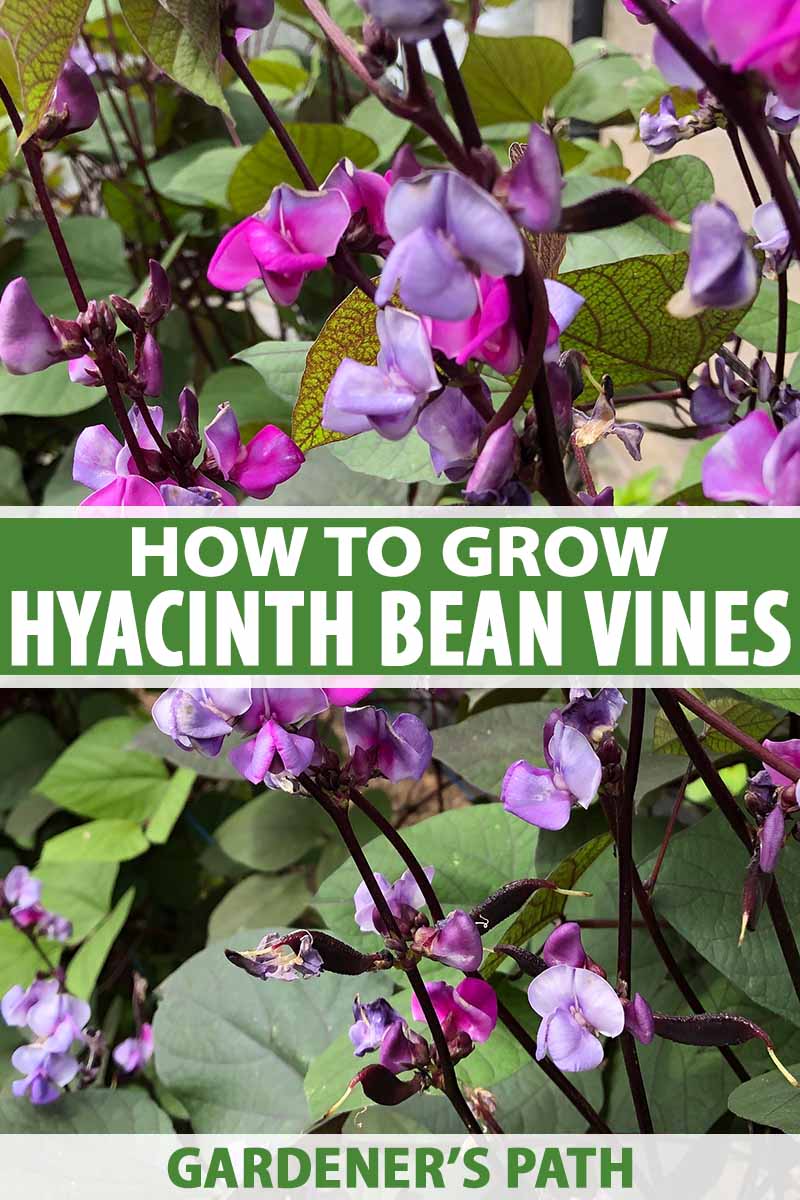
We link to vendors to help you find relevant products. If you buy from one of our links, we may earn a commission.
If you keep it moist but not soggy, instead of drooping in the heat like so many annual flowering vines, it will reward you with a growth spurt in early summer, and with blooms and pods all summer long.
What You’ll Learn
What Is Hyacinth Bean Vine?
A beloved cultivar still grown at Monticello, the historic home of third president of the US, Thomas Jefferson, the hyacinth bean first shows off with violet-tinged green leaves, each with three leaflets in an oval or triangle formation.
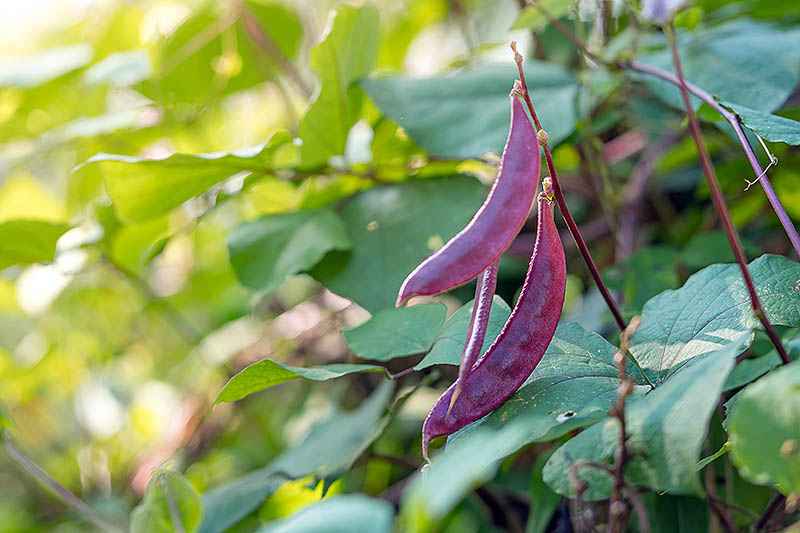
It then blooms profusely, with flowers that resemble sweet peas in purple, white, rose, or light red hues.
These clusters grow on short stalks and later form purple pods that are just as gorgeous. Each pod is three to six inches long, and contrasts dramatically with the foliage.
Want to start your own celebration of purple? Read on to learn how hyacinth beans can benefit your home and garden at every stage.
Are Hyacinth Beans Poisonous?
There is one drawback to growing hyacinth beans as part of a vegetable plot.
While you can enjoy the young shoots or the blooms as salad extras or edible garnishes, the mature or dried beans are toxic.
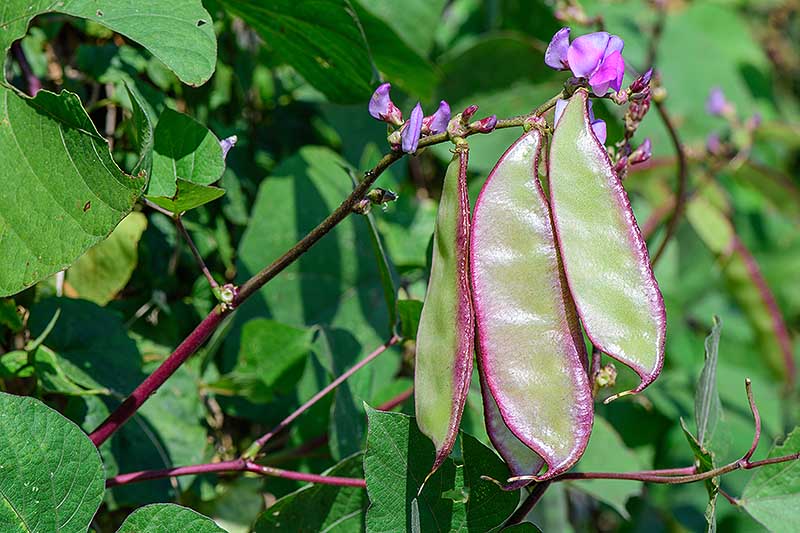
The culprit is the mature hyacinth bean’s cyanogenic glucoside levels.
To bring them down to a level that won’t cause vomiting, breathing problems, and possibly seizures, you must soak the beans and cook them in two changes of water.
Please use extreme caution if you plan to attempt this.
Only properly (and repeatedly) cooked mature hyacinth beans are edible, and cooks will tell you they also produce a pretty strong odor during the process.
If you’re interested in hyacinth beans as a food source, you do have options.
You may want to enjoy only the young shoots or blossoms – both are edible, and make a great addition to salads or soups.
Cultivation and History
Hyacinth beans originated in tropical regions of Africa, and date back to the New Stone Age in India, as well.
Certain cultivars are still grown and cooked in both areas, and in the tropics of Asia and Australia.
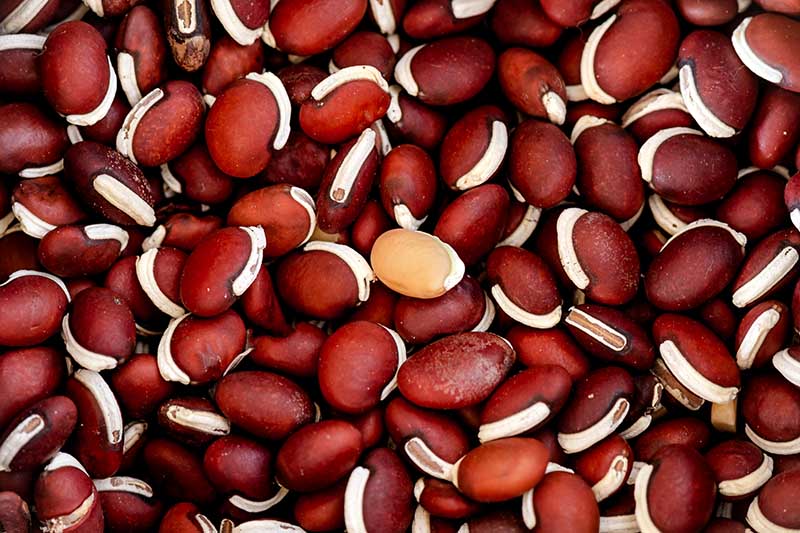
People in these countries eat young hyacinth bean pods raw or steamed, and in Asia both the beans and flowers are often used to make noodles, or a fermented product comparable to soybean tofu.
In India, the leaves are sometimes added to curries.
In America, hyacinth beans are commonly associated with Thomas Jefferson.
These beans, or perhaps another twining vine that resembled them, were grown in 1812 at his Virginia plantation, Monticello.
Today, an arbor of hyacinth beans still produces abundant purple pea flowers and fat magenta bean pods in a corner of the historic home’s vegetable garden.
In modern times, hyacinth beans are most popular in the South, where they’re typically grown for their ornamental value and to provide shade and privacy.
How to Grow Hyacinth Bean Vines
Huge seeds, germination in 7-10 days, beautiful purple pods all summer and into the fall, growth spurts worthy of Jack and the Beanstalk… is it any wonder hyacinth beans are a hit with beginners, and gardeners who seek low maintenance plants?

These legumes don’t need a lot of fuss, either. Their only “must-haves” include full sun and ample water. The soil can be average, as long as it drains readily.
Not a true bean but a fellow member of the pea family, showy hyacinth bean vines are more drought resistant than typical pole beans, but only if the drought hits after the plants are fully established.
They’ll also grow through bouts of high temperatures, particularly when these involve humid heat.
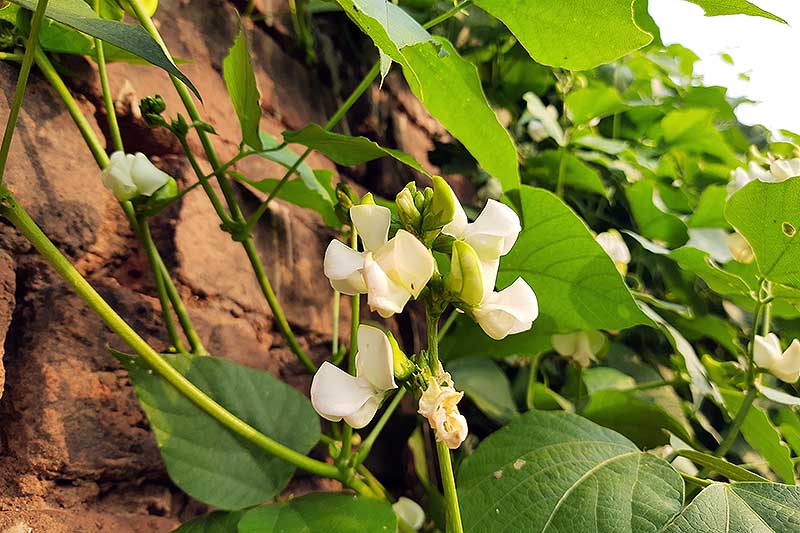
While they can be grown as perennials in USDA Hardiness Zones 10-11, most modern-day gardeners in the US tend to grow hyacinth beans as an annual.
Once they’re established, though, they’ll readily self-seed.
The only way for us home gardeners to grow hyacinth beans is to plant them from seed, either purchased or saved at the end of the growing season. You can’t take cuttings or divide existing plants.
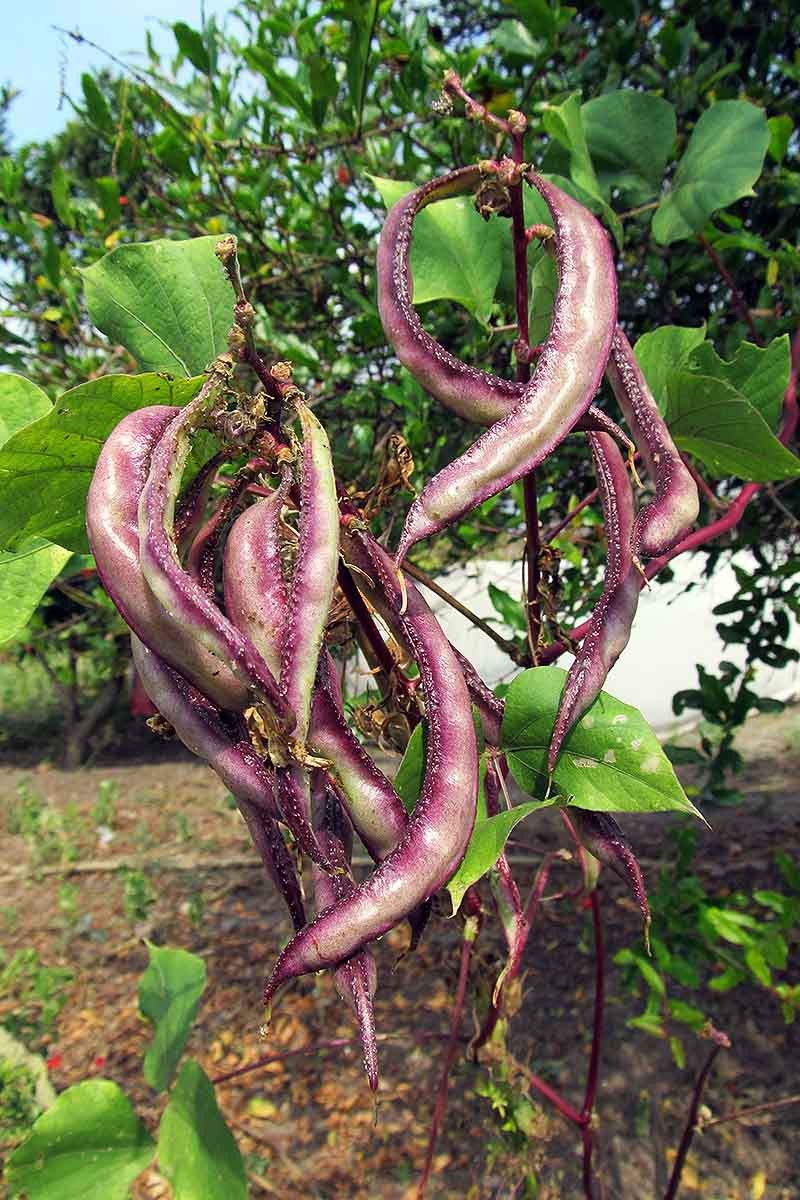
Wait for settled spring weather with nighttime temperatures reliably and consistently above 50°F.
Plant the seeds an inch and a half deep, firm the soil over them, and keep it well watered. But don’t drown your plants!
You can also get a head start if your season is shorter than 90 days by starting the seeds indoors.
Time the planting for four weeks before your last expected frost date. Make sure you’ll be able to provide ample light until transplant time, which will be sometime after the air has warmed and temperatures at night are above 50°F.
Hyacinth bean vines are renowned for covering ugly spots, or twining up fences or over arbors to provide shade or privacy. But don’t leave this design to chance!
Select a spot where the vine can climb and establish its trellis or other support right when you plant the seeds. Otherwise, young plants will sprawl all over the ground or garden plot and quickly become entangled.
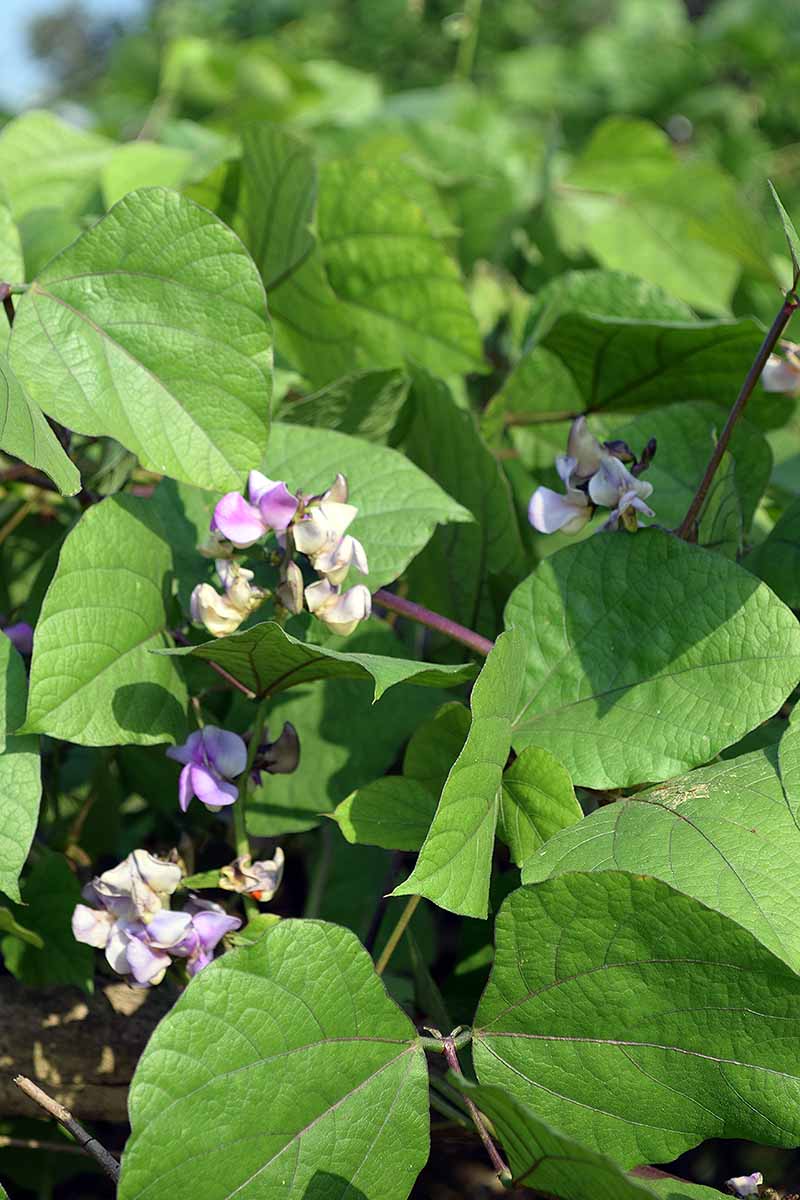
Make sure the support that you provide is sturdy and tall enough to hold 10 feet of vine with lots of side branches.
You may need to guide the young seedlings to the trellis initially. Once the vine twines through the support, though, it will attach itself as it continues to grow.
If the vine reaches the top of the support and it is still growing, it will double back to return to the earth. This creates that gorgeous canopy of leaves, blooms, and later pods.
At first, growth is gradual and mostly comprised of leaves. But as the weather warms up, hyacinth beans grow fast and furiously.
Expect blooms from mid- to late summer. Pods will start forming about 90 days after planting.
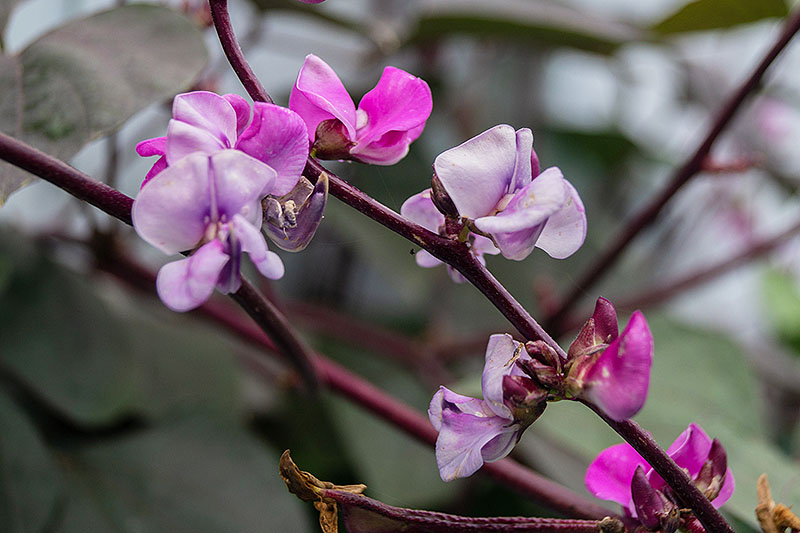
You may need to prune the vines for aesthetic purposes, or to keep them from growing too tall for your support.
They’ll never be candidates for razor-sharp topiary designs, but you can encourage hyacinth bean vines to be fuller and bushier by pinching back the seedlings after their first two or more sets of true leaves come in. This forces them to branch out.
When you notice flower production slowing in late summer, rejuvenate the vines and encourage a second round of blossoms by cutting each plant back to within six inches of the soil.
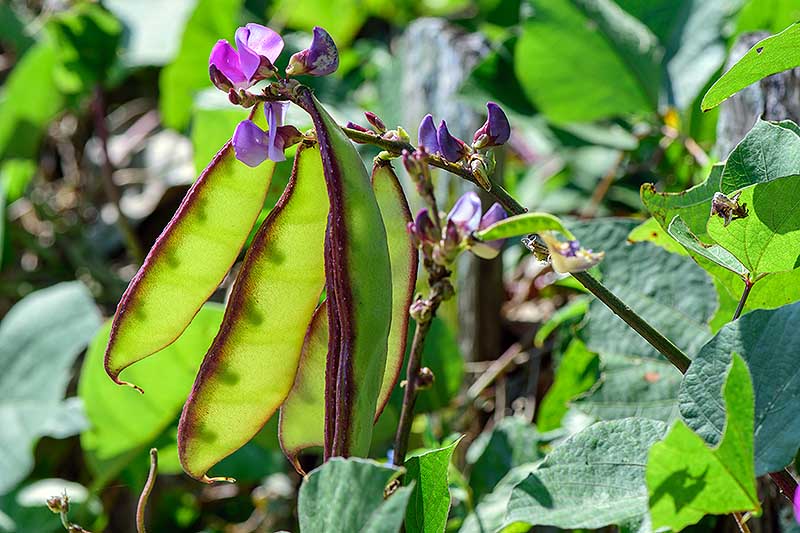
You may feel ruthless, but the plants will quickly grow back and burst into a second show of glorious scent and color.
As with any pruning, do the chopping just above a bud node, and use a sharp tool that you’ve recently sanitized. Otherwise, you risk killing the plant or introducing a bacterial infection.
Managing Pests and Disease
For all their beauty and culinary value, hyacinth beans are not dainty. They’re not typically susceptible to any diseases, and pests tend to pass them by. Here are a few pests and problems that you may encounter:
Japanese Beetles and Longtail Skipper Butterflies
It’s rare, but Japanese beetles may munch on the leaves.
And as the preferred host plant for longtail skipper butterflies, you may find caterpillars gobbling the greenery, too.
Happily, a healthy plant will persevere through either attack, and will tend to grow more prolific and fuller leaves as a result – though you may need to use an insecticide if the beetles are too oppressive. Typically, this won’t be a problem.
Blight, Wilt, and Rust
Common blight is a bacterial disease that appears as water-soaked spots on the leaves, and these soon grow to larger patches. The water-soaked spots can also afflict the vine’s stems.
See if you can spot them on the lower nodes. Undetected, they’ll kill the vine by girdling the stem or making it so fragile it breaks in two in heavy rain or strong wind.
Fusarium wilt, caused by Fusarium oxysporum fungi, will turn the lower leaves yellow to start.
In a short while, this opportunistic fungal disease will attack the whole plant. It may also be the culprit if a young vine’s growth is stunted.
Rust disease, caused by a fungal parasite, can make a hyacinth bean plant look like it’s been burnt or scorched.
It attacks any and all tissue, from shoots and leaves to those pretty purple pods. Wilted leaves and undersized or gnarled pods can also signify rust.
To avoid all three of these potential diseases, make sure to plant and prune hyacinth beans where they’ll enjoy ample air circulation.
Fungal diseases thrive in moisture, so don’t water seedlings or vines from above. Avoid picking blooms or pods or weeding when the plants are wet.
If you have no other option but to try to grow hyacinth beans in partial shade, you may be courting an increased risk of fungal disease. You’ll definitely have slower growth and fewer blooms this way as well.
If blight or wilt does take hold, you won’t be able to completely overcome it. Applying a copper-based bactericide or a suitable fungicide every seven to 10 days can help to control the symptoms.
As for the suspected rust, this is one of the times when you should treat a hyacinth bean just like one of its legume relatives.
First, cut off any infected leaves or stalks using loppers or scissors dipped in a half-and-half mixture of bleach and water before making each cut.
Once the rusted plant tissue is gone, treat the remaining vine surfaces with generous applications of copper-based fungicide or neem oil. Subsequently, keep a keen eye on the vines to spot any rust recurrences before they get out of hand.
Growing Tips
- Soak the seeds for 6-8 hours or overnight in warm water to speed germination.
- These climbers need support, and a wooden lattice or wire fence is best suited for the job. If you don’t have a fence, consider wrapping chicken wire around pillars for this purpose.
- To encourage young plants to start twining and growing up, up, and away, tie twine to the supports and guide the young tendrils to the twine by hand. It may take a couple of tries!
- Don’t fret if a seed supplier includes fewer seeds than you’d expect in your order. You only need four or five plants to cover an entire arbor or fence. And if you save the seeds yourself, you’ll have loads to grow or share next year.
Where to Find Hyacinth Bean Vine Seeds
Seeds labeled simply “hyacinth beans” but without a cultivar specified are available from most major seed houses and online.
You can find hyacinth bean seeds in a variety of packet sizes at Eden Brothers.
You can also find specific cultivars, like ‘Ruby Moon’ with its bicolor pink flowers and purple pods, from specialty and heirloom seed companies, and individuals who sell for a modest fee via the Seed Savers Exchange.
‘Silver Moon’ is a cultivar that produces white flowers and green pods.
You can find packets of 10 seeds available at Burpee.
In some areas, greenhouses and small farms sell hyacinth bean transplants.
Or, if you’ve grown one set of hyacinth bean vines successfully, you may be able to provide your own seeds for next year.
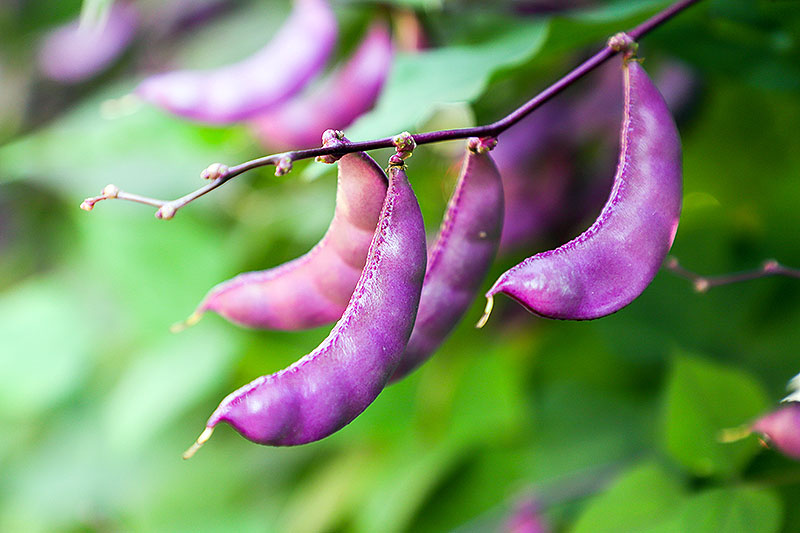
Once they dry at season’s end, pods on mature plants will literally pour viable seeds onto the soil if you leave the vines in place.
If you don’t want volunteers to grow next year, be sure to pull the vines up when a frost kills them, or before they release all their seeds.
If you’re happy at the thought of hyacinth bean vines coming back in the same spot next year with no effort from you, just make sure you don’t disturb the soil around the expired vines until the new shoots start to show. And be prepared to thin!
Harvesting Tips and Best Uses
Another appealing thing about this purple beauty is you can enjoy its ornamental appeal on the vine, or harvest something of value throughout the growing season.
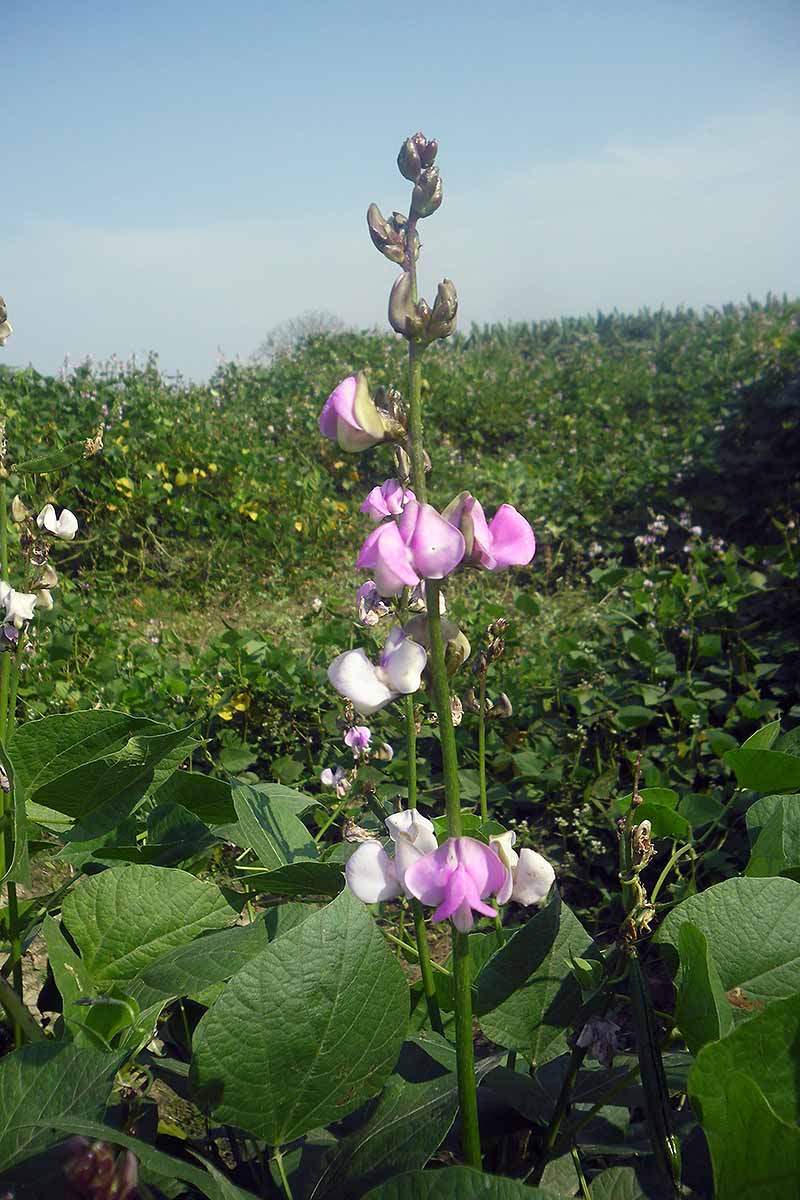
The shoots, for example, are edible. Harvest them when the first couple of sets of true leaves have appeared, and eat them on the spot or add them to salads.
The young leaves can also be steamed like spinach. While the older leaves are technically edible, they’re pretty tough even after steaming or a saute.

Once the vines are pretty big, they also produce an edible, large, starchy tuber. You can eat these steamed or baked, similar to other root vegetables.
If you do want to try this unusual food that’s popular in Asia, wait to dig the tubers until towards the end of the season, since harvesting them will kill the plant.
In USDA Hardiness Zones 8-11, it may be possible to overwinter the roots in the ground for consumption.

To try it, cut the vines to six inches from the soil and cover completely with a straw mulch.
The flowers are also edible, though you’ll want to make sure you don’t use any pesticides or herbicides if you intend to ingest these. They’re beautiful floating in a cream soup or on top of a salad.
Keep in mind that, like all edible flowers, you’ll want to pluck these literally minutes before you plate your food and eat, to maintain their freshness. You can read more about edible flowers on our sister site, Foodal.
A Note of Caution:
Mature hyacinth beans and pods contain cyanogenic glocosides, and they are toxic when raw. If you plan to consume them, be sure to consult an expert. Use caution and process them properly.
As for the pods, enthusiastic florists and amateur flower arrangers pick the stalks to use in arrangements after they’ve filled out, and before the seed pods start to get too plump or dry.
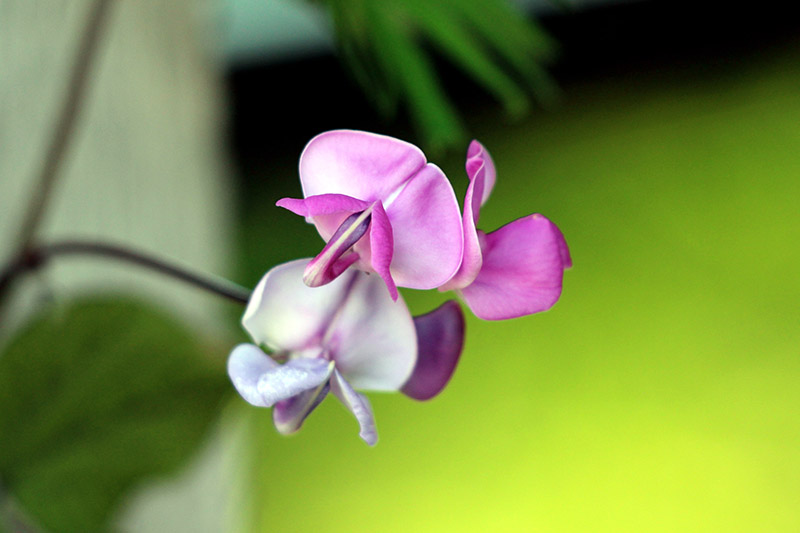
Because the stalks can grow to about 4 inches in length, “sprays” of magenta pods work well in floral arrangements set in shallow bowls or smaller vases, or they may be formed into all-natural napkin rings using twine.
Quick Reference Growing Guide
| Plant Type: | Tender perennial or annual flowering vine | Flower / Foliage Color: | Pink, purple, white; green |
| Native to: | Sub-Saharan Africa | Maintenance: | Low |
| Hardiness (USDA Zone): | 9-11, varies depending on cultivar | Tolerance: | Drought, humid heat |
| Season: | Summer/fall bloom | Water Needs: | Moderate |
| Exposure: | Full sun | Soil Type: | Average, loamy |
| Time to Maturity: | 90 days | Soil pH: | 6.0-6.8 |
| Spacing: | 6 inches | Soil Drainage: | Well-draining |
| Planting Depth: | 1.5 inches | Companion Planting: | Marigolds, mums, salvia |
| Height: | 8-10 feet, up to 25 feet with support | Uses: | Cut flowers, edible flowers, privacy screen |
| Spread: | 3-6 feet | Family: | Fabaceae |
| Growth Rate: | Fast | Genus: | Lablab (formerly Dolichos) |
| Attracts: | Hummingbirds, butterflies, other pollinators | Species: | purpureus |
| Common Pests: | Longtail skipper caterpillars, Japanese beetles | Common Disease: | Fusarium wilt, common blight, rust |
Tap Into Purple Power!
Ready to welcome this fast-growing, showy vine to your garden?
Whether you’re determined to lure butterflies, or aiming for a dramatic arbor or beautiful privacy screen, the hyacinth bean will deliver quickly.
Remember to nibble a few of the sprouts, or scatter some blooms on a summer salad or dessert.
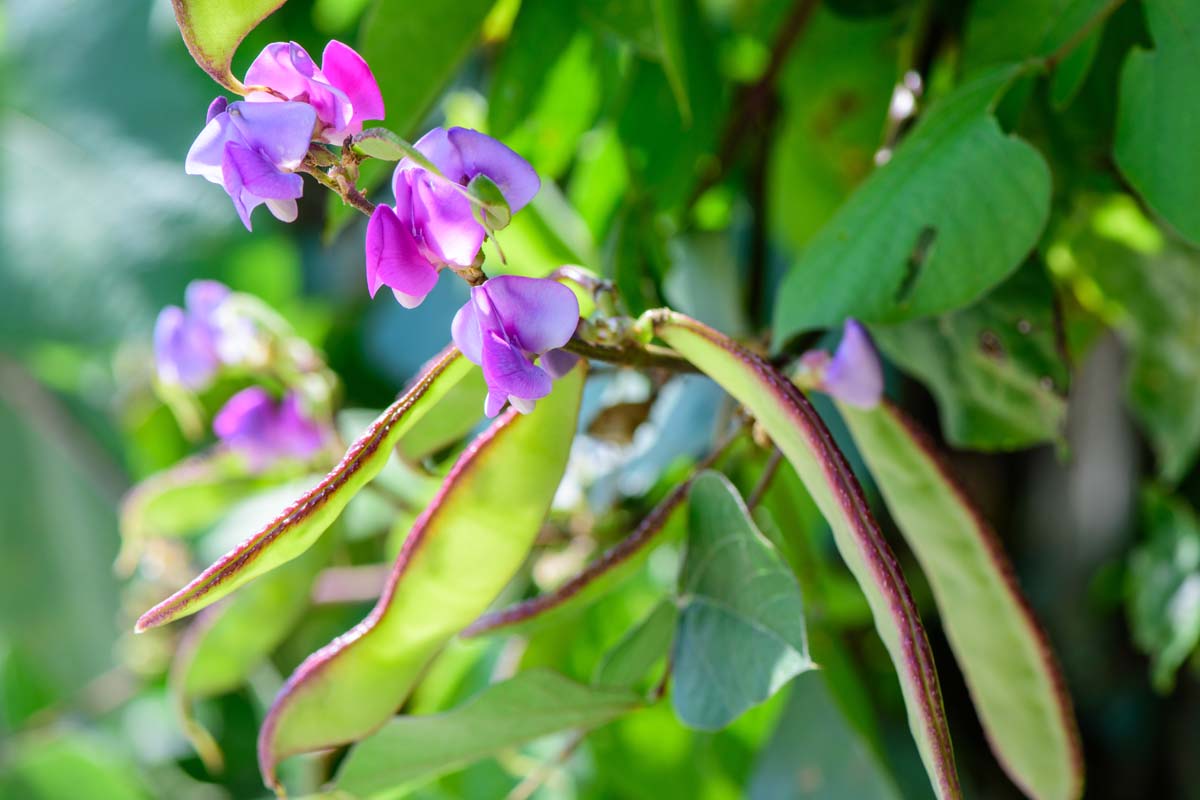
Should you discover that this multitasking, twining beauty has another function not mentioned above, let us know in the comments.
And if this purple climber has intrigued you, check out these other flowering vines that will help you turn your garden into a beautiful and restful haven:
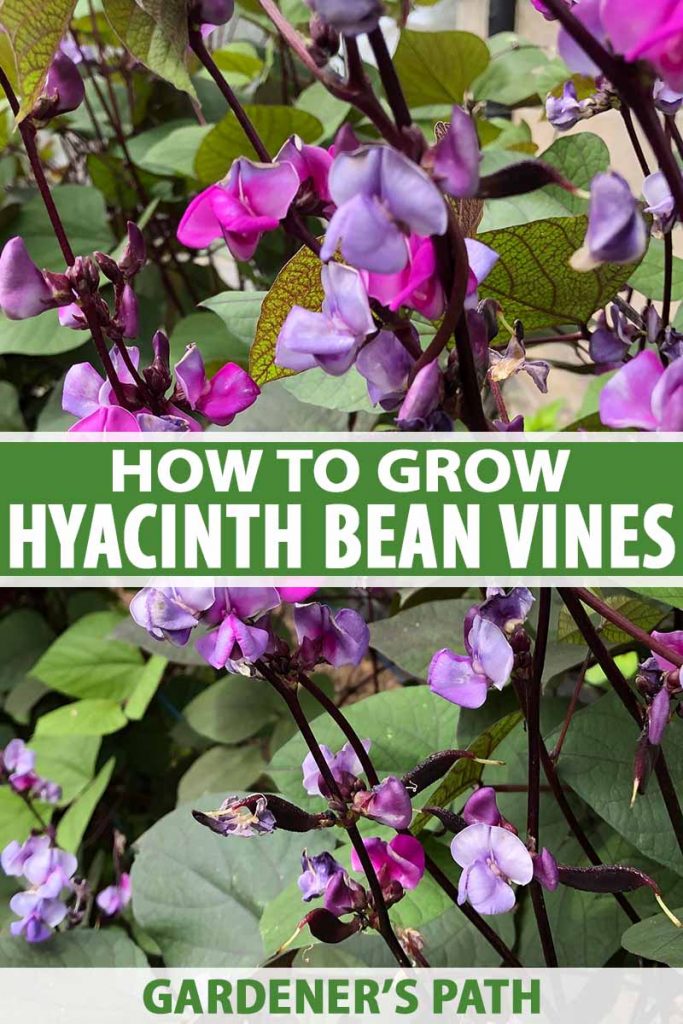
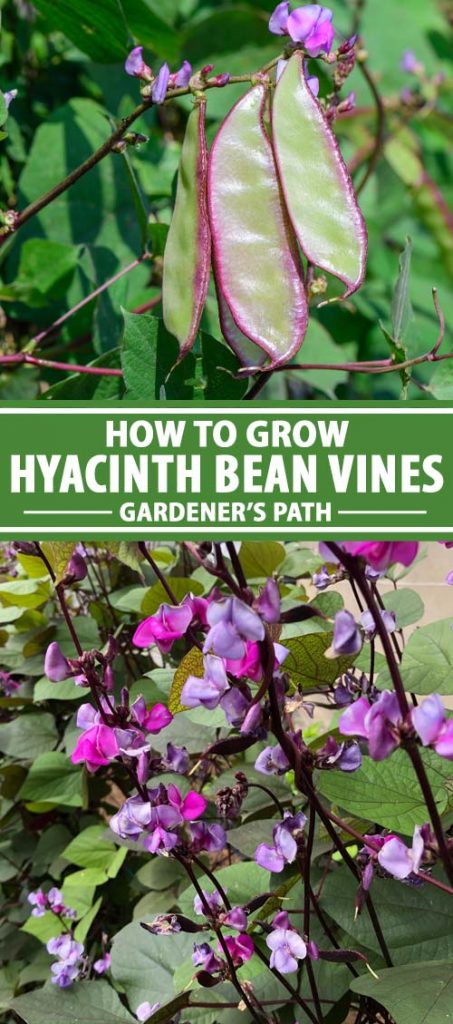
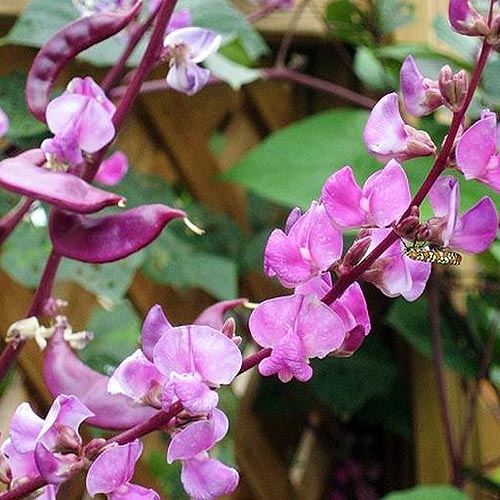
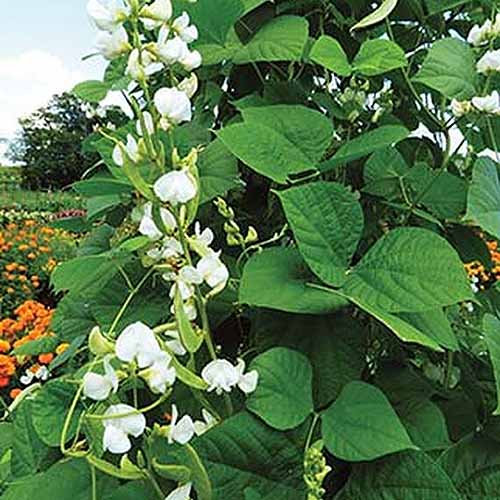
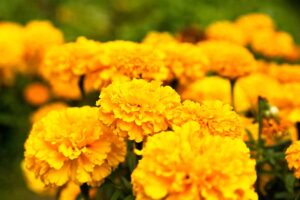
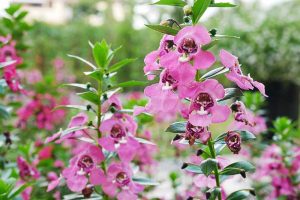

Will deer eat any part of the hyacinth bean vine? I would love to grow it but I don’t want to provide a salad for the deer. Thanks
Deer do not eat hyacinth bean vine. I had an entire fence of the vine and a herd of deer visit regularly, but the vine is not to their liking ????
This is lab lab and it’s actually a popular plant for hunters to attract deer with
Deer ate the leaves of mine. Left the stems and pods.
Live in Lake Havasu, Az zone 10a. Will they grow here?
Yes, they’re hardy in Zones 9-11, so they might even go to year-round. Let’s see some photos if you give it a try, Joyce!
I would love to see how this plant did! I live in the same desert. Mine are all indoor babies at the moment. Thanks!
Thank you for all of the info. I found seeds but was hesitant to plant them. Was afraid they would turn out like the morning glories which took over everything and I can’t seem to get rid of. Any ideas how to get rid of these? Are the hyacinth bean plants toxic to dogs? Thanks for your help.
Any source to find this vareity of beans?
This all sounds so wonderful but it sure didn’t work for me. Zone 5a, soaked seeds til visibly sprouting and planted around base of mailbox post. None came up. Sprouted another packet of 8 – 10 seeds, planted them, two produced seedlings. Rich black Iowa soil, full sun, watered them every day as it has been a very hot dry summer and they’d wilt otherwise. Beautiful, graceful little plants but after 2 1/2 months in the ground (we’re now into August and I planted in May) one is just now sending one tendril about a foot high, the other is… Read more »
Hello DRG. I’m sorry to hear you’re having a tough time and hope we can help. First, I am wondering if you soaked the seeds too long. They just need six to eight hours to speed germination–you don’t want them to be sprouting ahead of going into the ground. Also, you might want to check your soil pH around the mailbox. They prefer 6.0-6.8 pH, though they’ll usually do okay a little out of that range. One more thing to check: the water. It’s usually best to let the soil dry a little between watering, and then give them an… Read more »
Love the quality of information you provide. Keep me posted.
Thanks bunches, Tim, and will do.
If I want to harvest the seeds to plant the following spring, do I let the pods dry on the vine, or can I pick the pods and let them dry indoors?
Hello Judy. You’ll want to leave the pods on the vines until they are dry, and then harvest them before they start to pop and release the beans inside.
After you pick them, let them dry completely on a screen or piece of cardboard, in a cool dry place out of direct sun. Remember to wear gloves and husk the dried beans to save in an envelope or air tight container.
Good luck! I’d love to see or hear about your results if you get a minute.
If you peel the skins off the seeds and cook these with ginger garlic and chilli with tumeric, n cook it like rice, you will have The Best tasting pulse curry ever- most popular in Gujarat in India. Peeling off the skin of each seed, that is challenging but the final product is just too good
Thanks for sharing George!